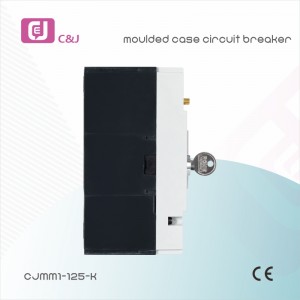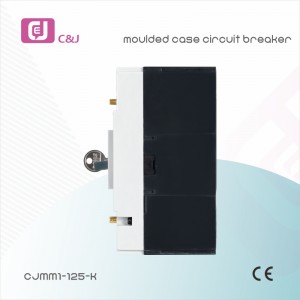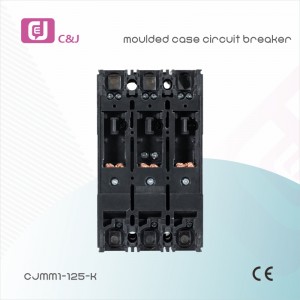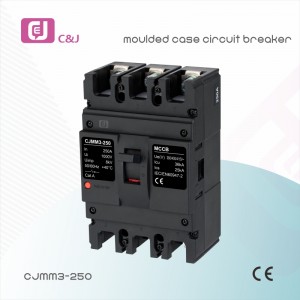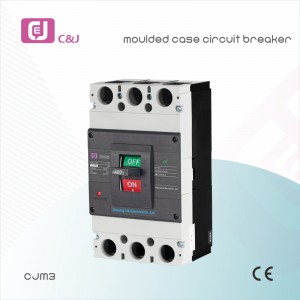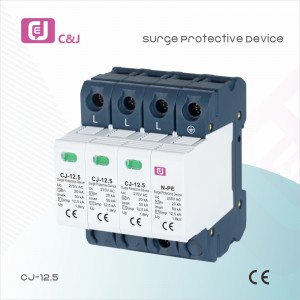CJMM1-125-K 3p 1000V 100A DIN Rail MCCB Moulded Case Circuit Breaker with Key
Product Model
CJ:Enterprise code
M:Moulded case circuit breaker
1:Design No
□:Rated current of frame
□:Breaking capacity characteristic code/S denotes standard type (S can be omitted)H denotes higher type
Note: There are four types of neutral pole (N pole) for four phases product.The neutral pole of type A is not equipped with over-current tripping element, its always switched on, and it is not switched on or off together with other three poles.
The neutral pole of type B is not equipped with over-current tripping element, and it’s switched on or off together with other three poles(the neutral pole is switched on before being switched off)The neutral pole of type C is equipped with over-current tripping element, and it’s switched on or off together with other three poles(the neutral pole is switched on before being switched off) The neutral pole of type D is equipped with over-current tripping element, it’s always switched on and is not switched on or off together with other three poles.
Table 1
| Accessory name | Electronic release | Compound release | ||||||
| Auxiliary contact,under voltage release,alam contact | 287 | 378 | ||||||
| Two auxiliary contact sets,alarm contact | 268 | 368 | ||||||
| Shunt release, alarm contact, auxiliary contact | 238 | 348 | ||||||
| Under voltage release,alarm contact | 248 | 338 | ||||||
| Auxiliary contact alarm contact | 228 | 328 | ||||||
| Shunt release alarm contact | 218 | 318 | ||||||
| Auxiliary contact under-voltage release | 270 | 370 | ||||||
| Two auxiliary contact sets | 260 | 360 | ||||||
| Shunt release under-voltage release | 250 | 350 | ||||||
| Shunt release auxiliary contact | 240 | 340 | ||||||
| Under-voltage release | 230 | 330 | ||||||
| Auxiliary contact | 220 | 320 | ||||||
| Shunt release | 210 | 310 | ||||||
| Alarm contact | 208 | 308 | ||||||
| No accessory | 200 | 300 | ||||||
Classification
- By breaking capacity: a standard type(type S) b higher breaking capacity type(type H)
- By connection mode: a front board connection, b back board connection, c plugin type
- By operation mode: a direct handle operation, b rotation handle operation,c electrical operation
- By number of poles: 1P, 2P, 3P, 4P
- By accessory: alarm contact, auxiliary contact, shunt release, under voltage release
Normal Service Condition
- The altitude of the installation site shall not exceed 2000m
- Ambient air temperature
- The ambient air temperature shall not exceed +40℃
- The average value shall not exceed +35℃ with in 24 hours
- The ambient air temperature shall not be less than -5℃
- Atmosphere condition:
- 1There lative humidity of atmosp here shall not exceed 50% at highest temperature of +40℃,and it can be higher atalower temperature,when theaver agelowest temperature in the wettest month doesn’t exceed 25℃ can be 90%,conden sationon product surfacedue to temperature change must be takenin to account.
- The pollution level is class 3
Main Technical Parameter
| 1 Rated value of circuit breakers | ||||||||
| Model | Imax (A) | Specifications (A) | Rated Operation Voltage(V) | Rated Insulation Voltage(V) | Icu (kA) | Ics (kA) | Number of Poles (P) | Arcing Distance (mm) |
| CJMM1-63S | 63 | 6,10,16,20 25,32,40, 50,63 |
400 | 500 | 10* | 5* | 3 | ≤50 |
| CJMM1-63H | 63 | 400 | 500 | 15* | 10* | 3,4 | ||
| CJMM1-100S | 100 | 16,20,25,32 40,50,63, 80,100 |
690 | 800 | 35/10 | 22/5 | 3 | ≤50 |
| CJMM1-100H | 100 | 400 | 800 | 50 | 35 | 2,3,4 | ||
| CJMM1-225S | 225 | 100,125, 160,180, 200,225 |
690 | 800 | 35/10 | 25/5 | 3 | ≤50 |
| CJMM1-225H | 225 | 400 | 800 | 50 | 35 | 2,3,4 | ||
| CJMM1-400S | 400 | 225,250, 315,350, 400 |
690 | 800 | 50/15 | 35/8 | 3,4 | ≤100 |
| CJMM1-400H | 400 | 400 | 800 | 65 | 35 | 3 | ||
| CJMM1-630S | 630 | 400,500, 630 |
690 | 800 | 50/15 | 35/8 | 3,4 | ≤100 |
| CJMM1-630H | 630 | 400 | 800 | 65 | 45 | 3 | ||
| Note: When the test parameters for the 400V, 6A without heating release | ||||||||
| 2 Inverse time breaking operation characteristic when each pole of overcurrent release for power distribution is powered on at the same time | ||||||||
| Item of test Current (I/In) | Test time area | Initial state | ||||||
| Non-tripping current 1.05In | 2h(n>63A),1h(n<63A) | Cold state | ||||||
| Tripping current 1.3In | 2h(n>63A),1h(n<63A) | Proceed immediately after No.1 test |
||||||
| 3 Inverse time breaking operation characteristic when each pole of over- current release for motor protection is powered on at the same time. |
||||||||
| Setting Current Conventional time Initial State | Note | |||||||
| 1.0In | >2h | Cold State | ||||||
| 1.2In | ≤2h | Proceeded immediately after the No.1 test | ||||||
| 1.5In | ≤4min | Cold State | 10≤In≤225 | |||||
| ≤8min | Cold State | 225≤In≤630 | ||||||
| 7.2In | 4s≤T≤10s | Cold State | 10≤In≤225 | |||||
| 6s≤T≤20s | Cold State | 225≤In≤630 | ||||||
| 4 The instantaneous operation characteristic of circuit breaker for power distribution shall be set as 10in+20%, and the one of circuit breaker for motor protection shall be set as12ln±20% |
What is MCCB?
Molded case circuit breakers are electrical protection devices that are designed to protect the electrical circuit from excessive current. This excessive current can be caused due to an overload or short circuit. The molded case circuit breakers can be used in a wide range of voltages and frequencies with a defined lower and upper limit of adjustable trip settings. In addition to tripping mechanisms, MCCBs can also be used as manual disconnection switches in case of emergency or maintenance operations. MCCBs are standardized and tested for overcurrent, voltage surge, and fault protection to ensure safe operation in all environments and applications. They work effectively as a reset switch for an electric circuit to disconnect power and minimize damage caused by a circuit overload, ground fault, short circuits, or when current exceeds the current limiting.
MCCB Application
An MCCB or fuse is an electrical component commonly used in industry to protect electronic equipment and systems. In daily life, MCCB is widely used. Some common MCCB applications are described below.
1.Energy distribution: MCCB can help installers distribute grid loads to different electrical equipment. Through MCCB, users can more safely control the distribution of power and the current of each device.
2.Short circuit protection: The main function of the MCCB is to automatically cut off the circuit when a short circuit occurs. This avoids equipment damage, release of dangerous substances such as fire.
3.Overload protection: Similar to short circuit protection, MCCB can also protect equipment from being overloaded. This can be achieved by setting circuit breakers to avoid electrical damage caused by overloading the equipment.
4.Generator protection: MCCB is widely used in the detection and protection of large generators. It can monitor the normal operation of the generator, detect problems and activate the circuit breaker protection system.
5.Power transformer protection: MCCB can prevent the transformer from overloading and monitor the transformer’s over-temperature at the same time.
6.Movable cylinder protection: MCCB is widely used in concrete, cement and mineral crushers. It detects short circuits and overloads of equipment, thereby protecting equipment from damage.
In conclusion, MCCBs are widely used and play an important role in various electrical and mechanical fields. When selecting an MCCB, various specific factors need to be carefully considered in order to ensure the safety and reliability of the system, including current carrying capacity, efficiency, usable area, and other important parameters.






